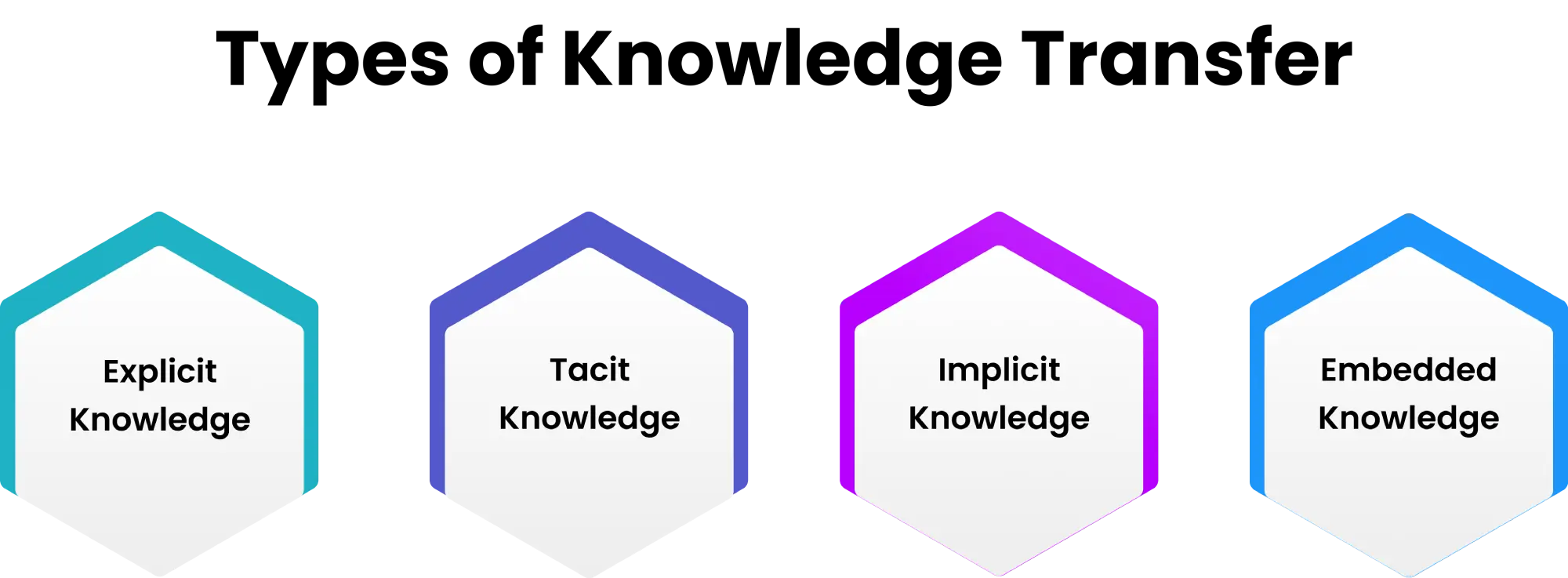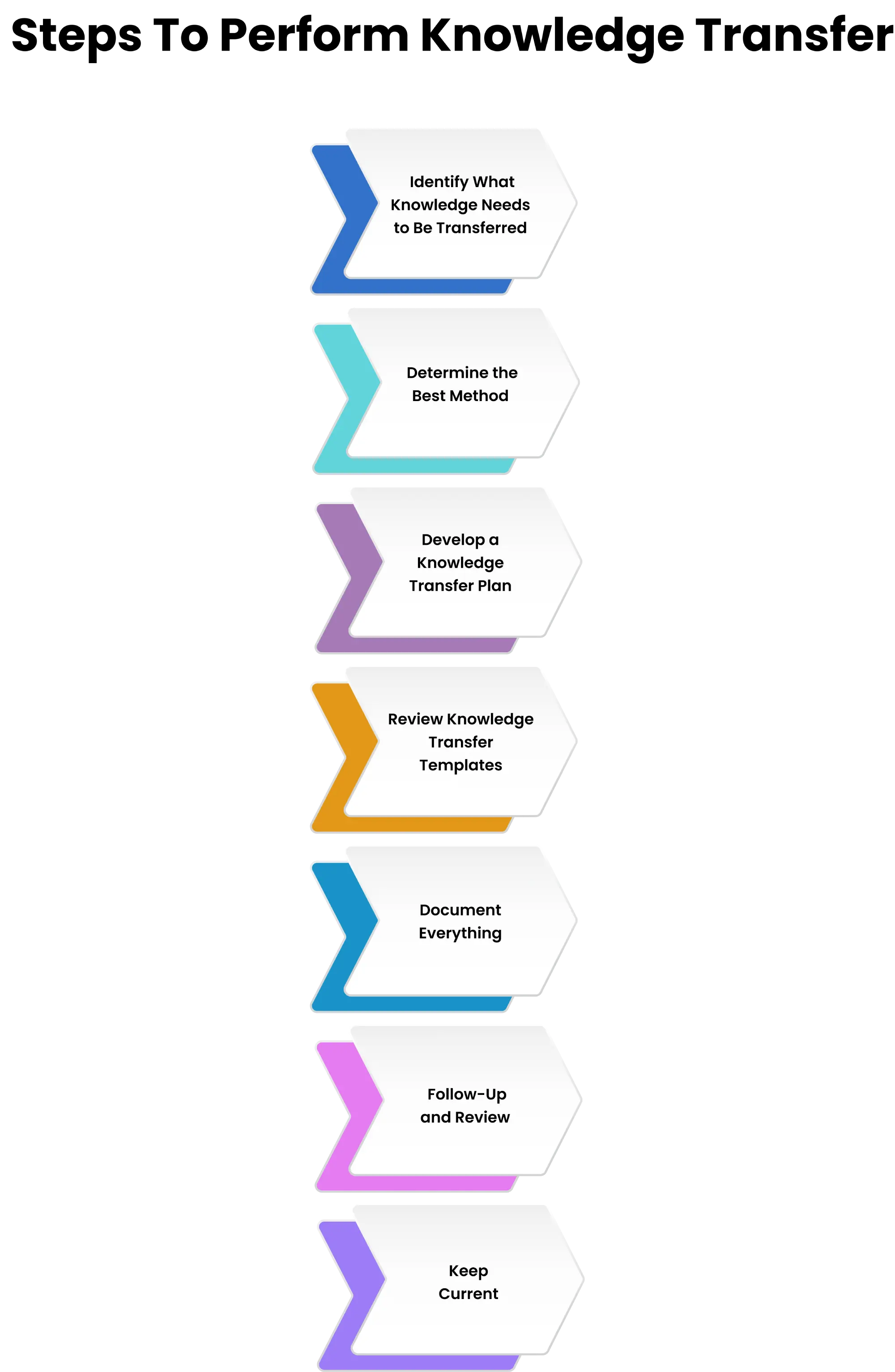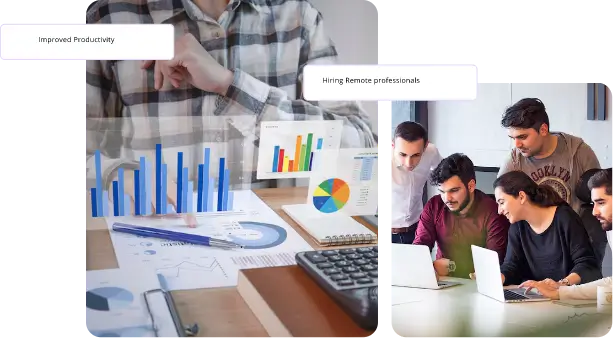Knowledge is possibly one of the most important assets businesses have in today’s ever-changing business environment. Knowledge is lost when an employee leaves their position, moves into another position, or retires. Knowledge transfer is important for business continuity, improving training experience, and ongoing development and growth.
Knowledge transfer is the transfer of the relevant knowledge, skills, and experience (including tacit and explicit knowledge) from one employee or department to another and can be defined as two types such as: "knowledge movement" or "knowledge retention". In this blog, we’ll discuss knowledge transfer, what it means, its importance, types/methods of knowledge transfer, and how knowledge transfer occurs successfully.
What is Knowledge Transfer?
Knowledge transfer refers to the process of transmitting key knowledge, skills, and experience from one person, group, or department to another to ensure continuity, productivity, and organizational learning.
Knowledge transfer is more than just a document-sharing activity; it involves the transfer of skills, experience, thought processes, and knowledge that will benefit a person's development, improve work performance, and foster success for the individual and the organization over the long term. It means imparting knowledge that the individual can confidently apply back into work. If implemented professionally with an emphasis on communication, organizations can facilitate knowledge transfer, foster growth, and efficiently sustain work.
When knowledge transfer can take on a regular position in the activities of the business, you are making a pledge to your people and, more importantly, your long-term success.
Knowledge transfer can be much more than just documenting information; it encompasses authentic communication (for example, mentoring, shadowing, training seminars, informal conversations ) that occurs through a variety of methods (for example, formally through documentation or workshops or informally through one-on-one conversations or on-the-job learning).
Knowledge transfer exists to ensure that knowledge is sustained within the organization. An employee who leaves (or moves to another position) takes specific knowledge with them, and this is how disruptions to productivity happen. Proper knowledge transfer can ensure organizations continue certain functions without stopping to train someone new.
Knowledge transfer will support employee onboarding but can also support role transitions (e.g., internal promotions) or transfer of accountability (e.g., project transition). It makes it more likely that teammates will be able to ramp up more easily and with fewer mistakes. It is when most innovation occurs in organizations, as knowledge shared tends to lead to new knowledge production and new ways of doing things.
In a technology company, BPO, health care, or in distance education, it is always important to be doing knowledge transfer to keep the organization operational, to educate other team members, and, importantly, safeguard the future of the organization.
Why Knowledge Transfer is Important in Organizations
Knowledge transfer is a necessary activity in every organization. It ensures that employee knowledge does not vanish when employees exit the organization (resigning, retiring, or moving on to other positions), which happens all too frequently. If knowledge transfer is not built into the experience of the new employee, learning and proficiency will take longer than necessary, timelines will lengthen, and if knowledge transfer isn't included in the new employee's onboarding, their learning and performance can take longer than anticipated. It could also affect how well their work is done and take longer.
Organizations that focus on effective knowledge transfer will be more productive overall and able to make decisions promptly. It reduces duplication of work, summation time for training, and creates an opportunity for consistency in customer service or a product.
Moreover, knowledge transfer supports collaboration, better teamwork, hybrid teams , and more engagement. When an employee can see that there is value, accessibility, and knowledgeable use of an organization's contributions, there is also personal motivation for the employee to add to the workplace by sharing knowledge. Generally, knowledge transfer creates a culture of learning, where teams are learning well, building on what they have learned, and can pivot quickly when learning or changing circumstances arise.
Ultimately, knowledge transfer will help in an organization that is working to maintain its essential knowledge and keep what is important alive, available, and usable.
What Are the Types of Knowledge Transfer?

Knowledge transfer can happen in a number of different ways, depending on the information being shared and how it is being shared. The types of knowledge transfer are combined into three basic categories:
1. Explicit Knowledge: This evidence-based knowledge is the most easily documented, stored, and shared. It consists of manuals, documents for processes, training collections, reports, checklists, and data. Explicit knowledge is often written or recorded, making this kind of knowledge shareable through files, presentations, and intranet systems.
2. Tacit Knowledge: Tacit knowledge is more challenging to capture. It is much more closely related to each individual's experience and their skills. It is what a senior employee has learned in years of work and likely has not written down so that others can easily learn from it. Tacit knowledge could be competencies like decision-making, problem-solving, tips for dealing with clients, or technical information about a software application. Tacit knowledge is shared through methods such as mentoring, job shadowing, or direct in-person experience.
3. Implicit Knowledge: Similar but slightly different than tacit knowledge, implicit knowledge may be able to be made into explicit knowledge if required. For example, an employee can use a software tool promptly. This could be reframed in a tutorial or guide to share with others.
4. Embedded Knowledge: This knowledge is embedded in processes, culture, routines, or tools. It is in workflows, product designs, or systems. When people work together, embedded knowledge is shared by following a set of processes.
What Are the Different Methods of Knowledge Transfer?
Organizations have various ways to transfer knowledge based on the context and type of knowledge:
1. Documentation: Documentation such as manuals, FAQs, SOPs (Standard Operating Procedures), and internal wikis can help retain and transfer this information.
2. Training Programs: Training sessions or workshops with a defined structure are great venues for passing information to new employees or across teams to share information or update employees.
3. Mentoring and Coaching: There are also processes where senior employees guide junior employees through mentoring or coaching to transfer their experiences and decisions. This method works very well in the transfer of tacit knowledge.
4. Job Shadowing: New or transitioning employees can observe experienced/effective employees on the job through job shadowing. Employees can learn the processes, skills, and decision-making in real time in their physical environment.
5. Transferring Knowledge Before Employees Exit: When an employee leaves, the recollection of their experiences, lessons learned, and pointers is valuable information for new employees or team members in the future.
6. Knowledge Repositories: Through modules, such as SharePoint or internal knowledge bases, the organization creates an organized space for shared knowledge repositories.
7. Team Meetings and Brainstorming Sessions: Team meetings and brainstorming sessions generate ideas for solutions to problems and facilitate knowledge sharing.
8. Cross-Training: If organizations cross-train employees for multiple roles, knowledge stays with more than one person and can be shared across teams.
How to Perform Knowledge Transfer Effectively
Knowledge transfers require a methodical approach. A few key steps include:

1. Identify What Knowledge Needs to Be Transferred: The first step is determining what knowledge is essential, including processes, tools, client information, and lessons learned.
2. Determine the Best Method: Depending on whether the knowledge is explicit or tacit, select the best transfer method. Use documents for knowledge that is written down, while using mentoring for knowledge learned by experience.
3. Develop a Knowledge Transfer Plan: Think laterally about how the transfer will occur, who will provide the knowledge, who will receive the knowledge, what tools or sessions will be used, and when the transfer will be completed.
4. Review Knowledge Transfer Templates: Using templates makes it easier to document knowledge in a clearly defined format. Templates require you to think through the depth of the knowledge being provided and ensure nothing is left out while also improving the understandability for the receiver.
5. Document Everything: If you are transferring knowledge in a meeting, phone call, or informal conversation, you still need to document it. You can keep it in a common place to allow others to review as needed.
6. Follow-Up and Review: Ensure that the knowledge has been integrated. Set a time with the person who received the knowledge to clarify and verify what they learnt.
7. Keep Current: Keep your knowledge current. Outdated knowledge is often the cause of mistakes, and knowledge should be reviewed and updated with regularity of all documents and guidance.
What Should Be Included in a Knowledge Transfer Document?
A knowledge transfer document is a way of documenting knowledge and communicating knowledge transfer. Here are some examples of the document to record:
- Basic Information: Includes the employee’s name, job title, department, and last working day, along with any other essential details required for record-keeping and formal processes.
- Roles & Responsibilities: A concise list of the employee’s key duties, tasks, and responsibilities, including individual and team contributions that support organizational goals.
- Current Projects: Current project information, status of completion, due dates, and who is involved in the project. It should also mention important deadlines, expected delivery dates, and the team members or departments involved.
- Key Contact: Key contacts for individuals and organizations within and outside of the organization. Having a central record of these contacts ensures quick access to the right people, minimizes confusion, and improves overall coordination.
- Tools and Software Used: Information on the various tools and software they used, access to their accounts, how to access anyone's account if they are part of the project, and other tips and tricks
- Processes/ Procedures: Step-by-step instructions outlining how to complete a major work task, ensuring consistency, accuracy, and adherence to organizational standards.
- Lessons Learned: What challenges they faced over the years, and what they did to overcome the challenges. These experiences provide valuable insights into what works and what doesn’t.
- Pending Work/ Handover notes: Work they may have yet to complete, and what next steps are recommended. Well-prepared handover notes prevent delays, reduce confusion, and help incoming team members or successors pick up where the work left off without losing momentum.
Overall, the purpose of the document is to help transfer work, cause less chaos, and reduce the downtime in the transition.
How Does Knowledge Transfer Benefit Organizations?
Organizational knowledge transfer is beneficial to the organization in several ways:
- Reduces Training Time- New employees learn more quickly, and there is a practical demonstration. By using real workplace examples, they adapt to processes more quickly and require less time to become productive in their roles.
- Improves Work Quality: Employees can learn from previous errors and discover what has worked and what has created errors. This approach builds a culture of continuous improvement, where best practices are reinforced, and quality standards are consistently met.
- Greater Work Continuity- Work stops happening less often because people are absent or have left the organization. This reduces disruptions, maintains productivity, and safeguards business processes against knowledge gaps.
- Increases Innovation- Ideas are shared and considered for developing new processes and solutions. This exchange of perspectives fosters creativity, leading to innovative processes, improved efficiency, and better problem-solving.
- Stronger Team Collaboration- Teams improve as team members understand each other's work, then build common understandings and common insights. This shared understanding builds trust, improves communication, and enables teams to work more cohesively toward common goals, ultimately enhancing overall performance.
- Preserve Workplace Culture: It is easier to maintain workplace culture when long-standing employees demonstrate, reinforce, and share the organization's core values . Although some core values may fade over time, having seasoned employees demonstrate and reinforce them helps maintain those that are most important.
It assists the organization as a whole to be more responsive, agile, and realistic with change.
What Are the Common Challenges Faced in Knowledge Transfer?
While knowledge transfer is a relevant concern, it can be very difficult.
- 1. Time: People may have so many other tasks, activities, and responsibilities that they are never in a position to adequately share what they know, especially at changeovers or near deadlines.
- 2. Poor Documentation: If a potential knowledge transfer is poorly documented or never updated, it may cause more confusion than relief.
- 3. Reluctance to Share: An employee may not want to share what they know because of obvious fears that their importance is going to be diminished, or they may not want to risk losing employment.
- 4. Undefined Process: When there is no pre-defined process or clear outline, it leads to confusion, inefficiency, and a lack of accountability in completing tasks.
- 5. Lost Tacit Knowledge: Tacit knowledge is much harder to capture. Learning takes place through socialization and interaction; otherwise, tacit knowledge may be lost.
To overcome these challenges, organizations must create a culture of knowledge sharing, provide opportunities for documentation, and support employees in publishing information developmentally.

